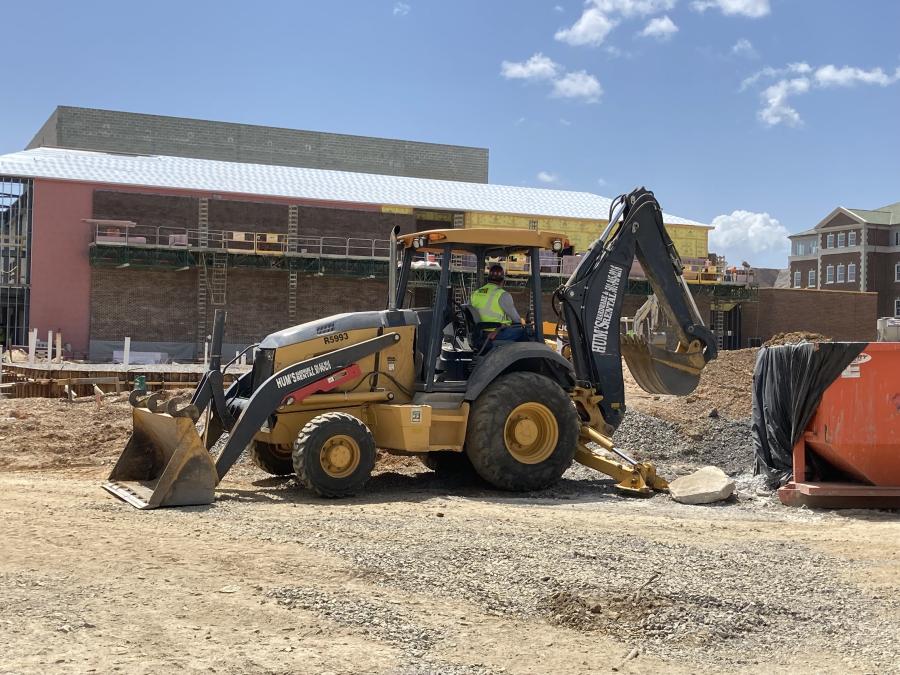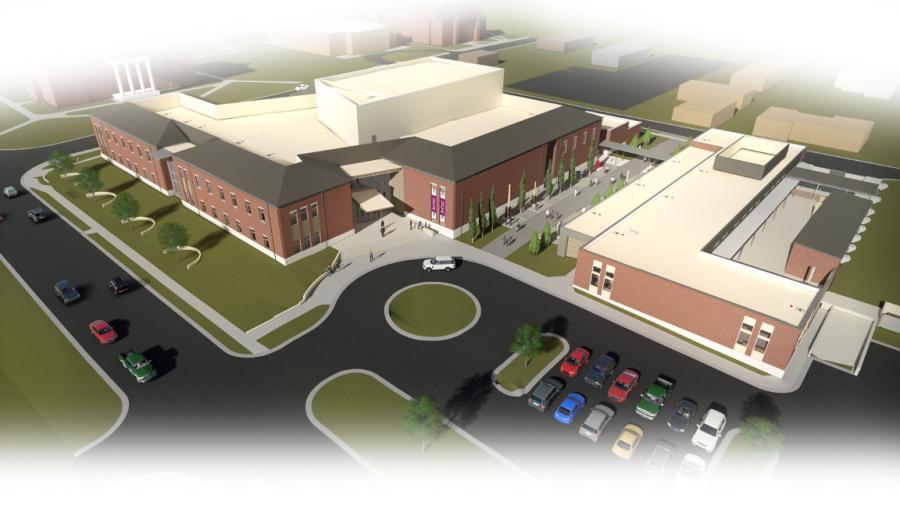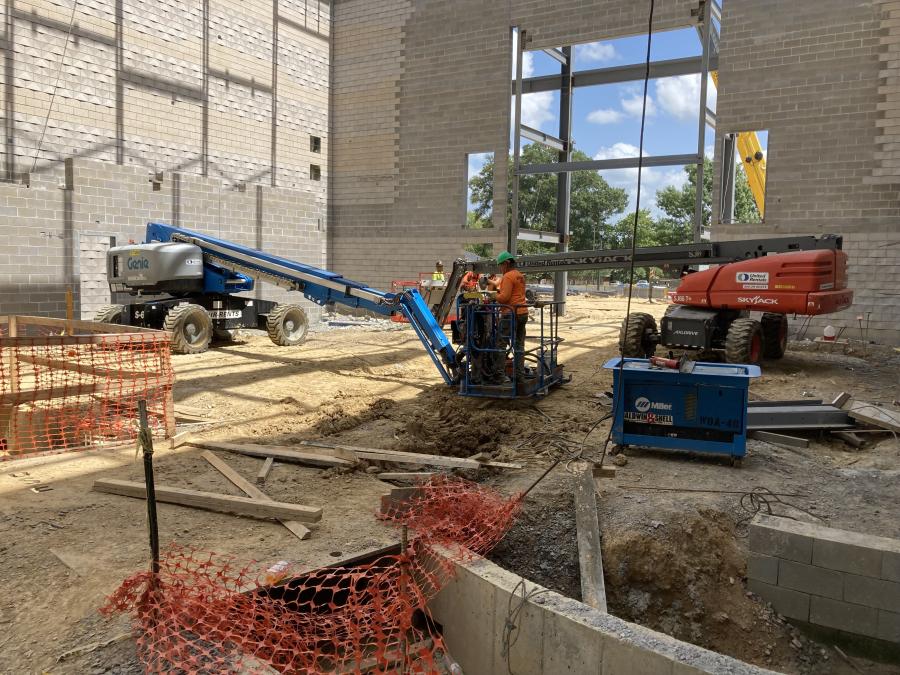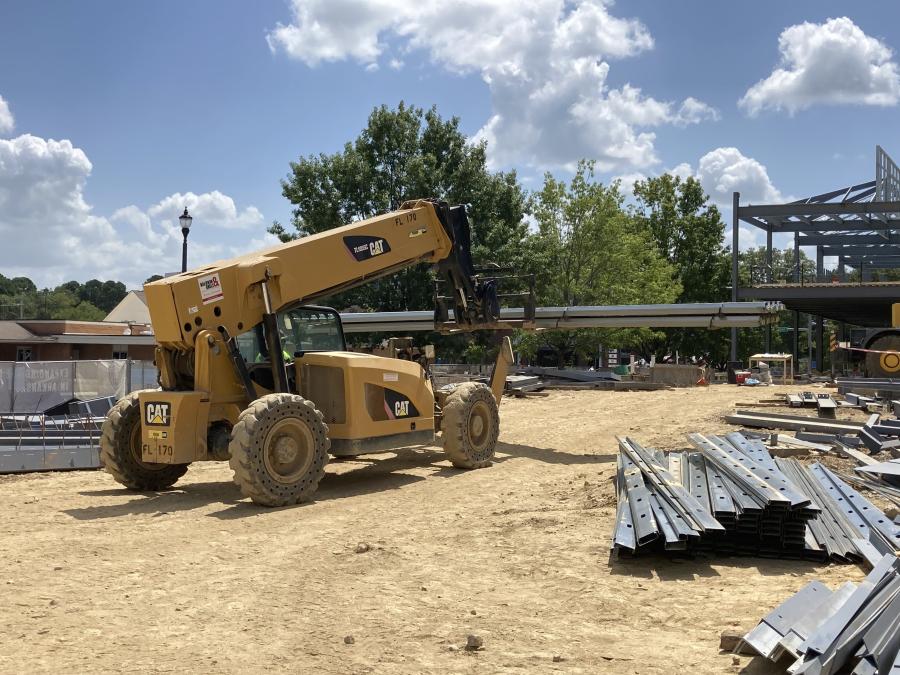Despite a record-setting snowstorm and a delay in obtaining materials, crews in Conway, Ark., remain on schedule constructing The Windgate Center for Fine and Performing Arts
(University of Central Arkansas photo)
Despite a record-setting snowstorm and a delay in obtaining materials, crews in Conway, Ark., remain on schedule constructing The Windgate Center for Fine and Performing Arts. The building, located on the University of Central Arkansas (UCA) campus, is scheduled to be completed in time for the fall 2022 semester.
"It's stunningly amazing watching the construction of this project," said UCA President Houston Davis. "Seeing the architectural design on paper could not have prepared many of us for the enormity of this project. And not just the size of the building, because that's evident every time you drive by or walk by the construction site."
UCA broke ground on the estimated $45 million project in October 2020. The building will serve faculty, staff, students, alumni and community patrons through its recital, theater and other spaces. The structure was designed to foster new partnerships for students and teachers across multiple academic disciplines.
"This new facility will provide 104,000 square feet of much-needed classroom, studio, rehearsal, performance, gallery and design spaces for the UCA departments of art and design, music, film, theatre and creative writing," said Davis. "The facility will provide opportunities to educate and prepare the next generation of artists, performers, educators, entrepreneurs and leaders in a collaborative way that lends itself to real-life scenarios that will occur in their professions. The Windgate Center will allow students to learn, create and perform in spaces designed specifically for this purpose."
Founded in 1907, UCA includes five academic colleges, Schedler Honors College, the graduate school and more than 150 programs. For Davis, the new building is an ideal addition to the university.
"The arts are an important sector of economic, social and cultural growth, development and economic health for communities. UCA has been an essential part of helping to grow and develop the local economy. A recent study indicated the university impacts the state of Arkansas to the tune of $1 billion. This center will further develop the arts and culture sector for our region.
"The university and departments involved are going through periods of growth, and this facility is allowing us to maintain that momentum and meet the student demand. This also will give our faculty access to the best facilities in the region."
Davis noted that a $20 million donation from the Windgate Foundation is the largest single gift in the school's history.
"It helped to solidify the university's position as a leader in the arts and culture, and it signaled to other funders that UCA is a good place to invest."
The Windgate Center will be home to the Arkansas Shakespeare Theatre. In addition, the concert hall will host events ranging from solo performances to full orchestra and chorus productions. The recital hall will be the site for smaller ensembles, student recitals and master classes. The entire mezzanine of the building is designed for various art installations and small concerts.
Classes will include drawing, painting, ceramics, sculpture, graphic design, illustration, digital arts, art history, interior design, scene design and fabrication, acting and directing, enhanced labs for digital content creation in film, choral and vocal music, orchestra and percussion.
Davis said the input from students, faculty and community has been extremely positive.
"The reaction has been excitement, and more students continue to be interested in UCA because of it."
Kevin Carter, UCA construction manager, said the biggest concern for crews has been the material delays due to COVID-19.
"They have been addressed by procuring materials in unconventional ways. Certain materials have been purchased from other contractors. We've had to expand our area basically coast to coast looking for the items we need.
"It's been a challenge keeping things on schedule and having to make adjustments for product delays and substitutions. Also, early on in the project, the weather was a challenge. We experienced a historic snowstorm in February that caused a two-week shutdown."
Currently, crews are working on the building envelope. Several construction milestones have already been reached, including the completion of slab pours, the concert hall block and four steel sequences. Tasks yet to be completed include the interior framing and finishes.
The building site was a large parking lot. Preparing the area required undercut and fill, along with 260 drilled piers. The pier depths range from 19 to 22 ft. and are 24 to 72 in. in diameter.
Workers have undercut and filled 14,000 cu. yds. of material, to date. A total of 25,000 cu. yds. of dirt will be moved on the project.
The job site size is small, so material delivery and storage have been a challenge. The city has been working on the road adjacent to the job, so there has been tight coordination in getting materials on site.
Carter said construction of the 175-seat black box theater and experimental lab call for concrete block, steel and load-bearing masonry, while the 450-seat concert hall requires decorative block (load-bearing), underground ductwork, laminated timber beams and sloped seating.
Drywall clouds, extensive ductwork and a large storefront are needed for the rehearsal/recital hall, while the percussion studio involves extensive soundproofing.
Equipment on the project includes a RT89DE Grove 90-ton crane; 65-ft. boom lifts; Skytracks; a Cat D8 dozer; and Cat 323 excavators. Steel, masonry, concrete and metal studs are among the main materials being used.
As for the most time-consuming part of the work, said Carter, "That would be the concert hall. It has very high-end finishes, as well as acoustical features that are complex to build."
The lead architect for the project is WET (Witsell, Evans, Rasco) of Little Rock, along with H&N Architects of Conway, Ark., partnering with Pfeiffer Architects of New York, a company that specializes in performance spaces. Engineering services are provided by Bernhard TME Engineering of Little Rock. Baldwin and Shell serve as the contractor.
"Baldwin and Shell Construction has extensive experience in working on performing arts and education buildings," said Carter.
"This knowledge and experience has been very advantageous for this project."
He added, "This is a landmark project that will not only impact our campus and local community but our entire region. It is a state-of-the-art facility that will serve our students for decades to come." CEG
Today's top stories























